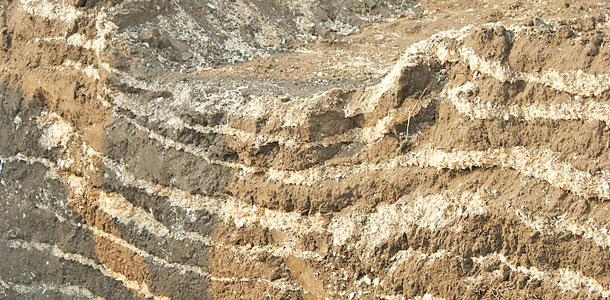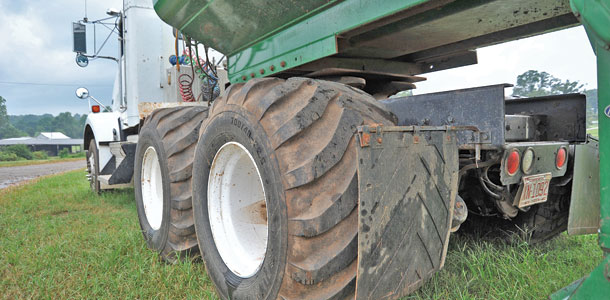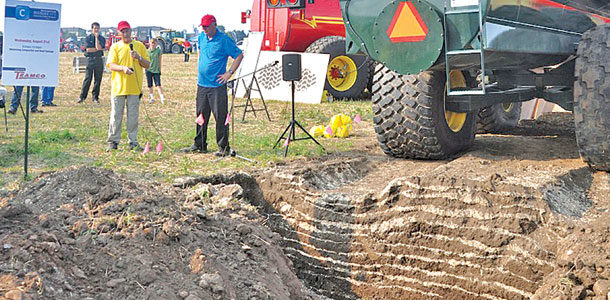Soil compaction squeezes the profit out of countless fields across the country, and it’s a particular challenge to many dairy producers because of the sheer weight of the equipment used in manure management. With today’s massive machinery – particularly manure tankers and spreaders – soil compaction layers can form more than a foot beneath the soil surface. Freeze-and-thaw cycles and deep ripping can help reduce surface compaction.
However, if the compaction layer is 15 inches deep or more, a pair of scientists from the U.S. and Sweden wrote, the condition is “virtually permanent.”
The yield impacts of soil compaction can be devastating. Research in Wisconsin and Iowa documented yield losses of up to 37 percent in alfalfa due to compaction, and studies across the country have recorded yield decreases ranging up to 30 percent in corn.
Soil compaction drags down fuel efficiency, too. In Illinois, researchers logged a tenfold to sixteenfold increase in energy use for low-speed tillage in compacted soils; another study calculated a 35 percent increase in fuel consumption for tilling compacted soil.
By any measure, soil compaction is a costly problem. Worse, it can last for years. Just look at the wheel ruts from the Oregon Trail, still visible in parts of Kansas after more than 150 years.
Invisible epidemic
Soil compaction is an invisible epidemic in which symptoms are often mistaken for nutrient deficiency, drought stress, herbicide damage or “wet feet.” Those mistaken diagnoses make soil compaction even more of a threat when they lead growers to try to address the wrong issues and distract them from the real problem at hand.
Tightly compacted soils present many challenges. Most crops have a very difficult time pushing tender young roots into compaction layers. The result is a smaller root mass to support the plant and shallower root systems that leave crops more susceptible to drought stress. In wet years, slow-draining soils can become waterlogged, drowning roots.
In fact, soil compaction also leads to the worst of both worlds in terms of moisture management – waterlogged soil followed by poor replenishment of soil moisture. Water infiltration can be severely limited by compacted soil, leading to ponding and runoff during major rain events. With that runoff goes valuable topsoil and nutrients.
Nutrients deeper in the soil can be out of reach of short roots. That limits crop potential and leaves the nutrients prone to leaching, runoff or volatilization, a huge waste of fertilizer dollars. Compacted soils are also more prone to denitrification, especially in wet years, leading to further losses of vital nitrogen.
Soil collapse
Soil compaction is largely a matter of physics. The soil in your field isn’t a solid mass – on a microscopic level, it’s a massive pile of sand, silt and clay, bits of organic matter, billions of microbes and glue-like substances that hold pieces together like mortar in a brick wall. Between particles, micropores capture air and water in tiny, empty spaces that can be pumped out by roots.

Think of the soil as a stone bridge. Some bridges are stronger than others due to their design, structure and materials. Soils are similar – there’s a breaking point, and some soils are particularly prone to collapse under heavy loads.
Basic questions
Because impacts are so devastating, and repairing compacted soils is difficult or impossible, minimizing soil compaction is vital to long-term success.
The most basic step is taking a serious look at soil conditions and determining if you ought to postpone or eliminate a trip across the field. Heavy, wet soils are particularly prone to compaction. In those conditions, ask yourself, “Is it worthwhile to wait until the field dries out a bit more before bringing out the manure tanker or the combine?”
Consider the machine itself. Is a fully loaded rig – for instance, a manure tanker – too heavy for the situation? Would your soils be better off if you hauled half or three-quarters of a load? That could cost you in time and passes but pay off dramatically in less compaction in the years to come.
Plan your route. Can you avoid wet spots and low areas? Can you use your GPS to follow in the tracks of previous passes, isolating compaction to a smaller proportion of the field?
Revolves around tires
Tires are the vital piece of equipment that can help minimize soil compaction. Tires translate the weight of the machine into downward force on the soil. If the tire can spread the weight across a larger footprint, the machine exerts fewer pounds of force – or compaction pressure – per square inch.
That’s why manure tankers and spreaders, grain carts, feed wagons and other heavy machinery are typically mounted with flotation tires or at least dual-wheel assemblies.
Even with the same-sized footprint, not all flotation tires are created equal. Engineers must work hard to design tires that spread axle weight evenly, without “hot spots” of added pressure on the shoulders of the tread, the edge of tread blocks or along bulges in the footprint. The tire must present not just a large footprint but also an even one, laying as flat as possible on the surface of the soil.
Radial flotation tires tend to create large, flat footprints. So does operating at the optimum inflation pressure, another variable you can control. As inflation pressure increases, the tire’s footprint becomes shorter and narrower, and downward force is concentrated increasingly toward the center of the contact patch.
It’s easy to calculate the impact of overinflation on soil compaction. The amount of compaction force exerted by a piece of equipment is equal to 1 to 2 pounds per square inch (psi) more than the inflation pressure of the tire it’s riding on.
So if a tire is operating at 18 psi, the machine exerts about 20 psi of pressure on the soil. The same machine operating on tires inflated to 30 psi will exert 32 psi of pressure on the ground surface. That’s more than 50 percent more force compacting the soil.

Optimize inflation pressure
There’s no single “right” inflation pressure, and it is critically important to consult manufacturers’ charts to determine the optimum inflation pressure for a specific machine in a particular situation. Optimum inflation pressure will vary by load, speed of travel and the construction of the tire.
Minimizing soil compaction is a key goal in our design process. When our engineers develop high-speed, high-flotation tires for manure tankers and spreaders, they design the whole tire around the goal of carrying axle weight at highway speeds at a minimal inflation pressure.
Applying manure and running heavy equipment across cropland are vital parts of running a dairy farm. But asking yourself a few questions and paying attention to your tires can help ensure that you’re protecting your land from the long-lasting impacts of soil compaction. PD
Steve Vandegrift is product manager for Alliance Tire Americas. Alliance is a global manufacturer of tires for every chore on the farm. Visit the website for more information or call (800) 343-3276. Email to receive a copy of a white paper on soil compaction.
PHOTOS
TOP: A soil compaction demonstration illustrates the difference between the force exerted by a radial tire at low inflation pressure (left) and a bias-ply tire of the same size at higher inflation pressure (right). Compaction force is equal to 1 to 2 psi more than the inflation pressure of a machine’s tires.
MIDDLE: By spreading axle weight across a broad, flat footprint, radial flotation tires inflated to the lowest appropriate pressure minimize the amount of soil compaction from a heavy manure tanker in this demonstration. Wood chips layered with soil highlight the compaction caused by the tanker.
BOTTOM: Some radial flotation tires are engineered for high-speed road transport, allowing manure applicators to move fast and minimize compaction. Photos courtesy of Alliance Tire Americas.








